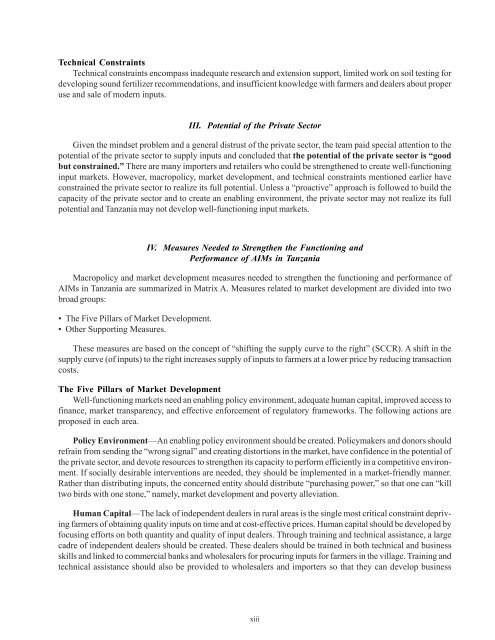An Action Plan for Developing Agricultural Input Markets in Tanzania
An Action Plan for Developing Agricultural Input Markets in Tanzania
An Action Plan for Developing Agricultural Input Markets in Tanzania
You also want an ePaper? Increase the reach of your titles
YUMPU automatically turns print PDFs into web optimized ePapers that Google loves.
Technical Constra<strong>in</strong>ts<br />
Technical constra<strong>in</strong>ts encompass <strong>in</strong>adequate research and extension support, limited work on soil test<strong>in</strong>g <strong>for</strong><br />
develop<strong>in</strong>g sound fertilizer recommendations, and <strong>in</strong>sufficient knowledge with farmers and dealers about proper<br />
use and sale of modern <strong>in</strong>puts.<br />
III. Potential of the Private Sector<br />
Given the m<strong>in</strong>dset problem and a general distrust of the private sector, the team paid special attention to the<br />
potential of the private sector to supply <strong>in</strong>puts and concluded that the potential of the private sector is “good<br />
but constra<strong>in</strong>ed.” There are many importers and retailers who could be strengthened to create well-function<strong>in</strong>g<br />
<strong>in</strong>put markets. However, macropolicy, market development, and technical constra<strong>in</strong>ts mentioned earlier have<br />
constra<strong>in</strong>ed the private sector to realize its full potential. Unless a “proactive” approach is followed to build the<br />
capacity of the private sector and to create an enabl<strong>in</strong>g environment, the private sector may not realize its full<br />
potential and <strong>Tanzania</strong> may not develop well-function<strong>in</strong>g <strong>in</strong>put markets.<br />
IV. Measures Needed to Strengthen the Function<strong>in</strong>g and<br />
Per<strong>for</strong>mance of AIMs <strong>in</strong> <strong>Tanzania</strong><br />
Macropolicy and market development measures needed to strengthen the function<strong>in</strong>g and per<strong>for</strong>mance of<br />
AIMs <strong>in</strong> <strong>Tanzania</strong> are summarized <strong>in</strong> Matrix A. Measures related to market development are divided <strong>in</strong>to two<br />
broad groups:<br />
• The Five Pillars of Market Development.<br />
• Other Support<strong>in</strong>g Measures.<br />
These measures are based on the concept of “shift<strong>in</strong>g the supply curve to the right” (SCCR). A shift <strong>in</strong> the<br />
supply curve (of <strong>in</strong>puts) to the right <strong>in</strong>creases supply of <strong>in</strong>puts to farmers at a lower price by reduc<strong>in</strong>g transaction<br />
costs.<br />
The Five Pillars of Market Development<br />
Well-function<strong>in</strong>g markets need an enabl<strong>in</strong>g policy environment, adequate human capital, improved access to<br />
f<strong>in</strong>ance, market transparency, and effective en<strong>for</strong>cement of regulatory frameworks. The follow<strong>in</strong>g actions are<br />
proposed <strong>in</strong> each area.<br />
Policy Environment—<strong>An</strong> enabl<strong>in</strong>g policy environment should be created. Policymakers and donors should<br />
refra<strong>in</strong> from send<strong>in</strong>g the “wrong signal” and creat<strong>in</strong>g distortions <strong>in</strong> the market, have confidence <strong>in</strong> the potential of<br />
the private sector, and devote resources to strengthen its capacity to per<strong>for</strong>m efficiently <strong>in</strong> a competitive environment.<br />
If socially desirable <strong>in</strong>terventions are needed, they should be implemented <strong>in</strong> a market-friendly manner.<br />
Rather than distribut<strong>in</strong>g <strong>in</strong>puts, the concerned entity should distribute “purchas<strong>in</strong>g power,” so that one can “kill<br />
two birds with one stone,” namely, market development and poverty alleviation.<br />
Human Capital—The lack of <strong>in</strong>dependent dealers <strong>in</strong> rural areas is the s<strong>in</strong>gle most critical constra<strong>in</strong>t depriv<strong>in</strong>g<br />
farmers of obta<strong>in</strong><strong>in</strong>g quality <strong>in</strong>puts on time and at cost-effective prices. Human capital should be developed by<br />
focus<strong>in</strong>g ef<strong>for</strong>ts on both quantity and quality of <strong>in</strong>put dealers. Through tra<strong>in</strong><strong>in</strong>g and technical assistance, a large<br />
cadre of <strong>in</strong>dependent dealers should be created. These dealers should be tra<strong>in</strong>ed <strong>in</strong> both technical and bus<strong>in</strong>ess<br />
skills and l<strong>in</strong>ked to commercial banks and wholesalers <strong>for</strong> procur<strong>in</strong>g <strong>in</strong>puts <strong>for</strong> farmers <strong>in</strong> the village. Tra<strong>in</strong><strong>in</strong>g and<br />
technical assistance should also be provided to wholesalers and importers so that they can develop bus<strong>in</strong>ess<br />
xiii

















